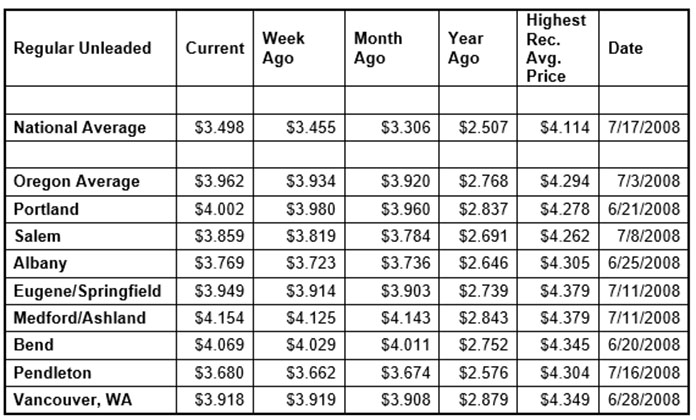Geopolitical tensions surrounding Russia and whether it will invade Ukraine continue to keep crude oil prices elevated. Crude has surged above $90 per barrel, about $36 higher than a year ago. This is the major driver of higher pump prices, as about 53 percent of what we pay for in a gallon of gasoline is for the price of crude oil.
For the week, the national average for regular rises four cents to $3.50 a gallon. The Oregon average gains three cents to $3.98.
The national average is at its highest price since August 2014; the Oregon average is the highest since July 2014.
Other factors contributing to higher pump prices include rising demand and shrinking supplies of gas in the U.S. Moderating winter weather and optimism over a potential fading of the omicron variant have led to the increase in gas demand.
“More drivers fueling up combined with a persistent tight supply of oil around the globe provide the recipe for higher pump prices. Unfortunately for consumers, it does not appear that this trend will change anytime soon,” says Marie Dodds, public affairs director for AAA Oregon/Idaho.
On average, about 53 percent of what we pay for in a gallon of gasoline is for the price of crude oil. 12 percent is refining, 21 percent distribution and marketing, and 15 percent are taxes, according to the U.S. Energy Information Administration.
The concern that Russia will react to potential western sanctions by withholding crude oil from the already tight global market puts heavy upward pressure on oil prices. Russia is a member of OPEC+, and any sanctions based on Russia’s actions toward Ukraine may cause it to withhold crude oil from the global market.
The price of crude oil has risen dramatically in the last two months. It was about $65 per barrel on Dec. 1 compared to $91 today on Feb. 15. Oil supplies were already tight and demand is expected to increase this year as global economies emerge from the coronavirus pandemic.
The cheapest gas in the nation is in Mississippi ($3.16) and Missouri ($3.17).
Oregon is one of 48 states and the District of Columbia with higher prices now than a month ago. The national average is 19 cents more and the Oregon average is four cents more than a month ago. This is the third-smallest monthly increase in the nation. Delaware (+33 cents) has the largest month-over-month increase. Utah (-6 cents) and Idaho (-3 cents) are the only states with month-over-month declines.
All 50 states and the District of Columbia have higher prices now than a year ago, and 22 states and D.C. have a current average that’s a dollar or more higher than a year ago. The national average is 99 cents more and the Oregon average is $1.19 more than a year ago.









